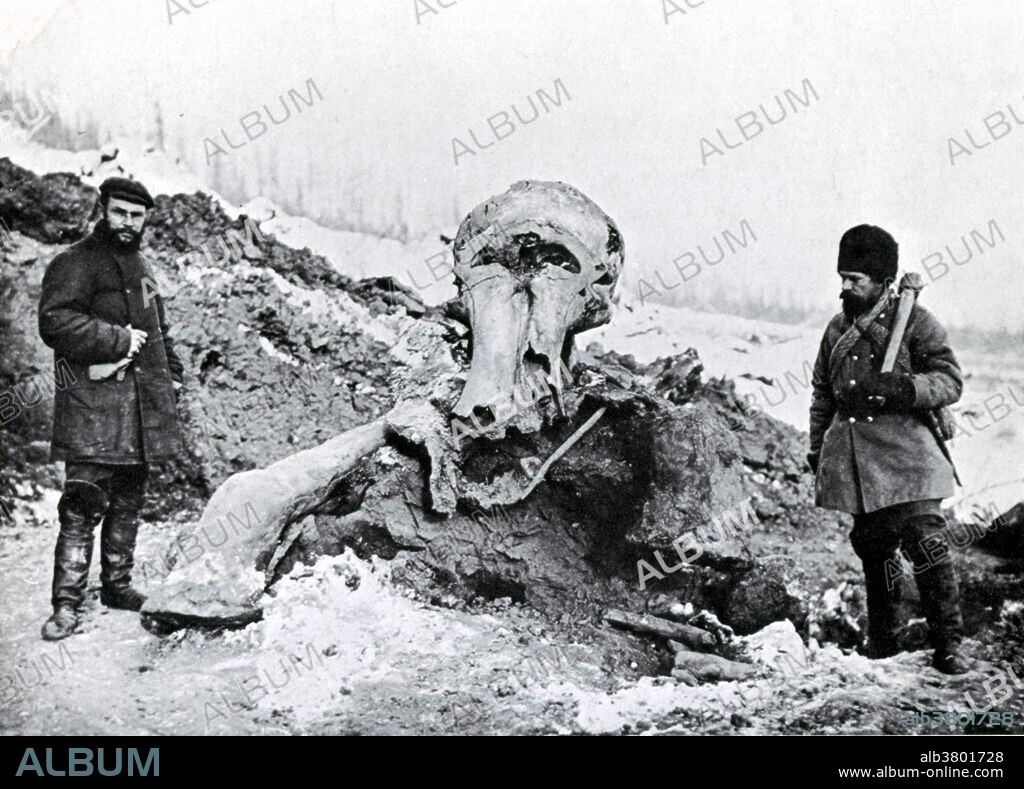alb3801728
Berezovka Woolly Mammoth, 1901

|
Add to another lightbox |
|
Add to another lightbox |



Title:
Berezovka Woolly Mammoth, 1901
Caption:
When the Berezovka mammoth was discovered sticking out of a river bank in Siberia, the flesh of its skull was partially eaten away by wolves, but its body and hugs front legs were perfectly preserved. E. W. Pfizenmayer was one of the scientists who recovered and studied the mammoth wrote: "Its death must have occurred very quickly after its fall, for we found half-chewed food still in its mouth, between the back teeth and on its tongue, which was in good preservation. The food consisted of leaves and grasses, some of the latter carrying seeds. We could tell from these that the mammoth must have come to its miserable end in the autumn." The Woolly Mammoth (Mammuthus primigenius), also called the tundra mammoth, is a species of mammoth. Unlike most other prehistoric animals, their remains are often not literally fossilized, turned into stone, but rather are preserved in their organic state. This is due in part to the frozen climate of their habitats, and to their massive size.
Credit:
Album / Science Source / New York Public Library
Releases:
Model: No - Property: No
Rights questions?
Rights questions?
Image size:
4266 x 3066 px | 37.4 MB
Print size:
36.1 x 26.0 cm | 14.2 x 10.2 in (300 dpi)
Keywords:
1900S • 1901 • 1901-02 • 1902 • 1990S • 20 XX TWENTIETH CENTURY • 20TH CENTURY • 20TH • 90S • AGE OF MAMMALS • ANIMAL: MAMMOTH • BEREZOVKA MAMMOTH • BEREZOVKA RIVEE • BEREZOVKA WOOLY MAMMOTH • BEREZOVKA • BW • CAINOZOIC • CELEBRITY • CENOZOIC • CæNOZOIC • DISCOVERY • EARTHWORK • ELEPHANTIDAE • ESCAVATED • EXCAVATION • EXPEDITION • EXTINCT • EXTINCTION • FAMOUS • FOLIVORE • FOSSIL • FOSSILIZED • GROUNDWORK • HERBIVORE • HERBIVOROUS • HISTORIC • HISTORICAL • HISTORY • IMPORTANT • MAMMAL • MAMMALIA • MAMMALIAN • MAMMALS • MAMMOTH FOSSIL • MAMMOTH • MAMMOTH, ANIMAL • MAMMUTHUS PRIMIGENIUS • MAMMUTHUS • NAVVYING • NINETIES • NINETIES, THE • NINETY DECADE • NOTABLE • PALAEOBIOLOGY • PALAEONTOLOGY • PALAEOZOOLOGY • PALEOBIOLOGY • PALEONTOLOGY • PALEOZOOLOGY • PHOTO • PHOTOGRAPH • PLANT EATER • PLANT EATING • PREHISTORIC • PREHISTORICAL • PREHISTORY • PRESERVED • PROBOSCIDEANS • RECONSTRUCTION • RESTORATION • RUSSIAN WOOLLY MAMMOTH • RUSSIAN • SCIENCE • SIBERIAN WOOLLY MAMMOTH • SIBERIAN • TERRESTRIAL VERTEBRATE • TUNDRA MAMMOTH • TWENTIETH CENTURY • VERTEBRATE • WELL-KNOWN • WOOLLY MAMMOTH
 Pinterest
Pinterest Twitter
Twitter Facebook
Facebook Copy link
Copy link Email
Email

